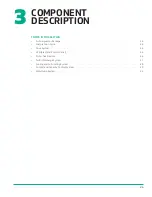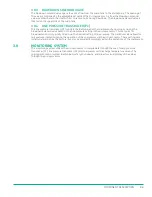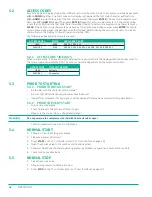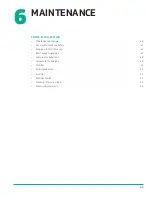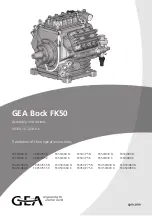
37
INSTALLATION
4.5
VENTILATION AND COOLING
The location where the compressor is installed must have adequate ventilation to maintain the rated
operating temperature of the compressor. For all compressors, a minimum of four feet of clearance is
recommended for proper airflow and heat rejection.
CAUTION!
Do not install a compressor without adequate freeze protection where it will be exposed to
temperatures below 32°F (0°C).
NOTE!
Heat rejection is the amount of heat radiated by the compressor. Fan air flow is the required volume of air
per unit time which must flow through the compressor for proper ventilation.
Duct hot air outside, if necessary, to prevent excessively high ambient temperatures. Ducting should never
be smaller than the size of the cooler face and may need to be enlarged to ensure proper air flow without
creating restriction. Use sweeps instead of 90° turns. heated air from the cooler may be routed to heat other
shop areas using a diverter in the duct. Inlet air may be ducted to the intake air filter(s) sized so a vacuum
greater than 0.25 in hg is not created at the air filter.
4.5.1
AIR-COOLED COMPRESSORS
For air-cooled compressors, the location where the compressor is installed must allow sufficient
unobstructed airflow in and out of the compressor to maintain a stable operating temperature.
4.5.2
WATER-COOLED COMPRESSORS
For water-cooled compressors, the cooling water supply must be checked for adequate temperature, flow
rate and pressure required to cool the compressor. The recommended water pressure range is
40
–75 psig
(2.8–5.2 bar). Refer to
for cooling water flow rates. Water flow rates will vary by
operating conditions. Consult the nearest representative for flow rates based on criteria other than what is
listed.
4.6
ELECTRICAL CONNECTIONS
All internal wiring is done at the Factory; however all electrical connections must be checked for tightness
due to possible loosening during shipping and installation. Check the electrical service for adequate wire
size and capacity. The electrical enclosure supplied with your compressor must be appropriate to the area in
which it is installed. NEMA 1 enclosures are standard, but all other ratings are optional upon request.
NOTE!
A certified electrician must install the compressor in accordance with the National Electric Code (NEC), local
electrical codes and Occupational Safety and Health Administration (OSHA) worker safety regulations. The
compressor must also be grounded properly in accordance with all applicable codes.
Three-phase supply power terminates atconnections L1, L2, and L3 on the main compressor motor
contactor.
Make sure the
wire is of sufficient size for the amperage of the compressor.
WARNING!
Ensure a tight electrical and mechanical connection and verify there are no loose strands of wire sticking
out. The ground wire must be connected at the designated ground terminal lug inside the electrical panel
and securely tightened. Any conduit termination (or entrance into the starter enclosure) must be sealed
properly to maintain the original rating for the enclosure.
Machines with sound-reducing enclosures must have the power supply conduit routed continuously through
the sound enclosure, without termination at the sound enclosure panels. Entrance into the sound enclosure
should be made with consideration of future needs to remove panels for maintenance or service without
disturbing the electrical installation and to maintain sound attenuation.
4.7
FLUID LEVEL CHECK
After installing the compressor and before starting the compressor for the first time, verify that the fluid
level is correct. The compressor is Factory-filled with the correct amount of fluid before shipping. If the
compressor has the right amount of fluid the sight glass should be
showing ½ to ¾ full while the compressor
is off. If the fluid level is low or empty, check for leaks before doing anything else. If fluid must be added then
remove fill cap and fill to proper level. Replace and tighten to SAE specification.
CAUTION!
Do not overfill. The system could produce excess fluid in compressed air lines and controls.
4.8
DIRECTION OF ROTATION
CAUTION!
Reverse rotation will cause damage that is not covered by the warranty.
NOTE!
Rotation must be checked whenever the compressor has been moved to a new location or after any change or
reconnection of the main electrical wiring.
Summary of Contents for UD Series
Page 6: ...vi About This Manual ...
Page 12: ...4 Introduction ...
Page 42: ...34 Component Description ...
Page 52: ...44 Operation ...
Page 66: ...58 Troubleshooting ...
Page 74: ...66 Parts Catalog 8 5 COMPRESSOR FRAME AND DRIVE ASSEMBLY Figure 8 1 AS801 25UD 50UD VFD R00 ...
Page 76: ...68 Parts Catalog 8 6 CONTROL ASSEMBLY OPEN Figure 8 2 1072190415 609 R00 ...
Page 78: ...70 Parts Catalog 8 7 STARTER ASSEMBLY ENCLOSED Figure 8 3 AS802 405060 PANEL R03 ...
Page 94: ...86 Parts Catalog 8 15 COOLING ASSEMBLY AIR COOLED Figure 8 11 AS804 50UDAC INLINE R00 ...
Page 100: ...NOTES ...
Page 101: ...NOTES ...



